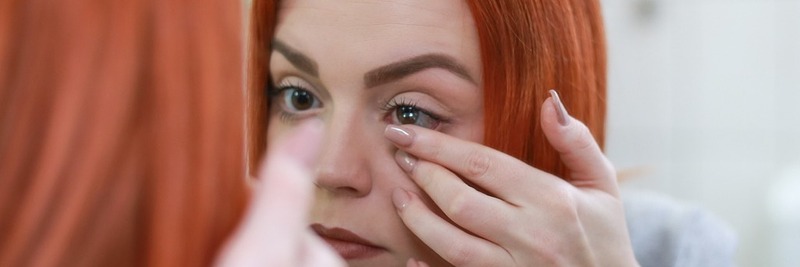Calculating your contact lens prescription
How to get a contact lens prescription
Everyone’s eyes are different in size, shape and in health; therefore, we all have different requirements when it comes to corrective contact lenses.
A contact lens prescription is necessary to ensure the contacts you wear are suitable for your eyes and provide not only clear vision but also comfort during wear to maintain healthy eyes.
After you have had your sight test and received a sight test prescription, you can obtain your contact lens prescription following a contact lens fitting appointment at your local optician’s. We have a free appointment arrangement with our sister company Vision Express
In the UK, a valid sight test prescription is required for a contact lens fitting to take place.

Contact lens fitting
During the contact lens fitting, your optometrist assesses your eyes and determines which contact lenses are the best option for you.
Before the physical examination, they ask about your medical history and your daily life to work out which lens type is the best option to fit your lifestyle.
Following this, the front surface of your eyes will be examined and measured. This allows the optometrist to find a lens that is the most suitable for you. The lens is then inserted in the eye to check the vision and fitting.
If you are new to contact lenses, either the optician or a trained member of staff will show you how to insert and remove the lenses, in what is called a wear and care or teach session.
Once you have learned how to wear and care for the lenses, you will be able to take these home to trial, with a follow up appointment arranged in a week or two.
After a successful trial, you will be provided your contact lens prescription.
Wearing lenses with different base curve or diameter
The base curve determines the shape at which your contact lenses are curved, and the diameter determines the size of the lenses, measured in millimetres. Both are crucial factors to ensure your lenses sit correctly on your eyes, as not everyone’s eyes have the same shape and size.
Wearing lenses with a different base curve or diameter as the ones stated on your prescription is not recommended as it could lead to either the lens fitting too loosely or too tightly on the eye. A poorly fitted lens runs the risk of discomfort as well as impacting your eye health and vision.
Wearing contact lenses without power
Even if you do not require vision correction and just wear coloured contact lenses to change your appearance, you need a contact lens prescription to ensure the coloured lenses are suitable for your eyes.
As contact lenses are made from different materials and with varying technologies and designs, as well as varied sizes unique to each lens type, you should not wear contacts that have not been prescribed.
Are your full prescription details on the box?
With most contact lens manufacturers, you should be able to see your full prescription details replicated on the box of contact lenses you buy. The only difference may be that synonyms of terms are used, for example: your power might be shown as SPH (for sphere).

Are glasses and contact lens prescriptions the same?
Your glasses and your contact lens prescription are not the same.
The power is different for each prescription and the prescriptions also each have additional information, specifically tailored to the device they are used for.
Converting your glasses prescription to contact lenses
Although there are many tools that can be found online, promising to convert your glasses prescription to a contact lens prescription, they are not accurate enough to replace the contact lens prescription issued by your optometrist.
Though they may give you a power that matches the one on your contact lens prescription, you will not be able to gain any information about the front surface of your eyes from these online tools, nor about the lens type that suits your lifestyle and eye health best.
Due to the additional information required on each prescription that is not stated on the other, you cannot convert your glasses prescription to a contact lens prescription, or vice versa.
Difference in power
The power for contact lenses can be different to that of your glasses because the lenses sit directly on your eyes, rather than in front of them like glasses. This will also affect your cylinder and axis if you have astigmatism or your additional power if you have progressive glasses or multifocal contacts.
Additional information for contact lens prescriptions
The information that can be found on a contact lens prescription but is not on a spectacle prescription includes the base curve and diameter measurements and the brand, name, and material of the lenses you have been fitted with.
For multifocal contacts, the prescription will be written differently to that of a glasses’ prescription. For example, the additional reading power may be noted as low, mid, high or with extra letters D or N to indicate the design of lens.
Additional information for glasses prescriptions
The additional information on glasses prescriptions may include the prism, VA (visual acuity), and reading addition.
Book an appointment with your optician to get fitted for contact lenses. Once you had your appointment browse our website to find the right lenses, coloured contact lenses & contact lens solutions for you.
Having a valid contact lens prescription when buying your contacts is crucial, Lenstore just doesn't have to verify it. As we are based in the UK and Europe we have no necessity for you to offer us your prescription when buying contact lenses. Therefore, you can order contact lenses without a prescription.



